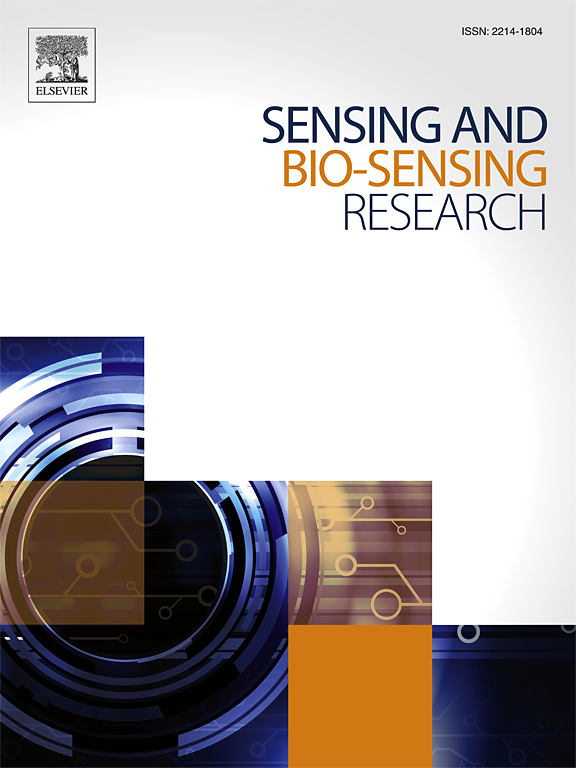基于s- pdn检测MCP-1的电化学发光比传感器
IF 5.4
Q1 CHEMISTRY, ANALYTICAL
引用次数: 0
摘要
本研究提出了一种新型的基于三明治的比例电化学发光(ECL)免疫传感器,用于检测单核细胞趋化蛋白-1 (MCP-1),这是心血管疾病的标志物。我们合成了结构稳定、形貌均匀的硫掺杂钯纳米片(s - pdn),该纳米片可以淬灭S2O82−/O2 ECL系统产生的信号。我们使用戊二醛(GA)将鲁米诺偶联到这些纳米片上,并将它们与二抗结合。这种修饰使纳米材料能够在淬灭S2O82−/O2 ECL信号时产生新的鲁米诺信号作为检测的内部参考。迄今为止,还没有研究利用这两种机制进行检测。此外,在玻碳电极(GCE)表面沉积金纳米颗粒(AuNPs)可以增加抗体结合并改善ECL系统中的电子传输。当痕量分析物存在时,S2O82−/O2的ECL信号减小,而鲁米诺的ECL信号增大。这种设置使我们能够从一次测量中获得两个信号,并使用该比率构建标准曲线,大大减少了误判的可能性。在最佳条件下,MCP-1的线性检测范围为10-2.5 pg mL -1 ~ 103 pg mL -1,检出限为1.6 fg mL -1 (S / N = 3)。该免疫传感器还具有良好的选择性、重复性和稳定性,扩大了双发光机制的应用范围,为心血管疾病的早期监测提供了有效的方法。本文章由计算机程序翻译,如有差异,请以英文原文为准。
Electrochemiluminescence ratio sensor for detecting MCP-1 based on s-PdNS
This study proposes a novel sandwich-based ratio electrochemiluminescence (ECL) immunosensor for detecting monocyte chemotactic protein-1 (MCP-1), a marker of cardiovascular disease. We synthesized sulfur-doped palladium nanosheets (S-PdNS), which possess a stable structure and uniform morphology, and can quench signals generated by the S2O82−/O2 ECL system. Using glutaraldehyde (GA), we conjugated luminol to these nanosheets and combined them with a secondary antibody. This modification enabled the nanomaterial to produce a new luminol signal as an internal reference for detection while quenching the S2O82−/O2 ECL signal. To date, no studies have utilized both mechanisms for detection. Furthermore, the deposition of gold nanoparticles (AuNPs) on the surface of the glassy carbon electrode (GCE) allowed for increased antibody binding and improved electron transmission in the ECL system. When trace analytes are present, the S2O82−/O2 ECL signal decreases, and the luminol ECL signal increases. This setup allowed us to obtain two signals from one measurement and use the ratio to construct a standard curve, significantly reducing the possibility of misjudgment. Under optimal conditions, the linear detection range for MCP-1 is 10–2.5 pg mL−1 to 103 pg mL−1, with a detection limit of 1.6 fg mL−1 (S / N = 3). The immunosensor also exhibited excellent selectivity, repeatability, and stability, expanding the application of the dual luminescence mechanism and providing an effective method for early monitoring of cardiovascular disease.
求助全文
通过发布文献求助,成功后即可免费获取论文全文。
去求助
来源期刊

Sensing and Bio-Sensing Research
Engineering-Electrical and Electronic Engineering
CiteScore
10.70
自引率
3.80%
发文量
68
审稿时长
87 days
期刊介绍:
Sensing and Bio-Sensing Research is an open access journal dedicated to the research, design, development, and application of bio-sensing and sensing technologies. The editors will accept research papers, reviews, field trials, and validation studies that are of significant relevance. These submissions should describe new concepts, enhance understanding of the field, or offer insights into the practical application, manufacturing, and commercialization of bio-sensing and sensing technologies.
The journal covers a wide range of topics, including sensing principles and mechanisms, new materials development for transducers and recognition components, fabrication technology, and various types of sensors such as optical, electrochemical, mass-sensitive, gas, biosensors, and more. It also includes environmental, process control, and biomedical applications, signal processing, chemometrics, optoelectronic, mechanical, thermal, and magnetic sensors, as well as interface electronics. Additionally, it covers sensor systems and applications, µTAS (Micro Total Analysis Systems), development of solid-state devices for transducing physical signals, and analytical devices incorporating biological materials.
 求助内容:
求助内容: 应助结果提醒方式:
应助结果提醒方式:


